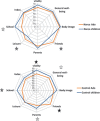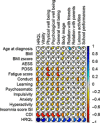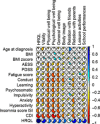Quality of life in children with narcolepsy
- PMID: 24922610
- PMCID: PMC6493048
- DOI: 10.1111/cns.12291
Quality of life in children with narcolepsy
Abstract
Aims: To evaluate the health-related quality of life (HRQL) and its correlates in children and adolescents with narcolepsy.
Methods: We compared the clinical characteristics of control subjects and patients with primary narcolepsy from data collected at the National Reference Centers for Narcolepsy.
Results: The cohort included 69 control subjects (29 boys) and 117 patients (65 boys; 59 de novo patients). Cataplexy was present in 81% and DQB1*0602 was positive in 91%. The control children were older (13.5±3.2 vs. 11.6±3.1 years, P<0.001) and less obese (1.4% vs. 60%, P<0.001). Twenty-five percent of the patients and 15.6% of the control subjects had clinically significant depressive feelings on Children's Depression Inventory (CDI≥16) (NS). Fifty-three narcoleptic and 43 control adolescents, 31 narcoleptic children and 23 control children filled out the HRQL questionnaires as well as 83 parents of patients and 60 parents of control subjects. Narcolepsy seriously impacts HRQL in terms of vitality, physical well-being, relations with friends and leisure activities, especially in adolescents. Depression was the factor that most affected HRQL in both narcoleptic and control subjects. For the control subjects and the narcoleptic patients, when the CDI score was entered into the multivariable regression model adjusted for gender and age, no other continuous independent variable could significantly increase the likelihood of the model. When the CDI score increased by 1, the mean HRQL score decreased by 1.7 for narcoleptic patients and 1.5 for control subjects. Apnea-hypopnoea index, diagnosis delay, disease duration, obesity, the presence of cataplexy or treatment had no effects on HRQL.
Conclusions: Narcoleptic children and adolescents were at high risk for poor HRQL. Depressive symptoms had a major impact on HRQL. We recommend a more thorough assessment and management of psychological health in this population.
Keywords: Child; Depression; Narcolepsy; Quality of life; Sleep.
© 2014 John Wiley & Sons Ltd.
Conflict of interest statement
The authors declare no conflict of interest.
Figures




References
-
- Sapin C, Simeoni MC, El Khammar M, Antoniotti S, Auquier P. Reliability and validity of the VSP‐A, a health‐related quality of life instrument for ill and healthy adolescents. J Adolesc Health 2005;36:327–336. - PubMed
-
- Ganz PA. Impact of quality of life outcomes on clinical practice. Oncology (Williston Park) 1995;9:61–65. - PubMed
-
- Ohayon MM, Priest RG, Zulley J, Smirne S, Paiva T. Prevalence of narcolepsy symptomatology and diagnosis in the European general population. Neurology 2002;58:1826–1833. - PubMed
-
- Medicine AAoS . The international classification of sleep disorders. Diagnostic and coding manual, 2nd edn Westchester, IL: Medicine AAoS, 2005.
MeSH terms
LinkOut - more resources
Full Text Sources
Other Literature Sources
Miscellaneous

